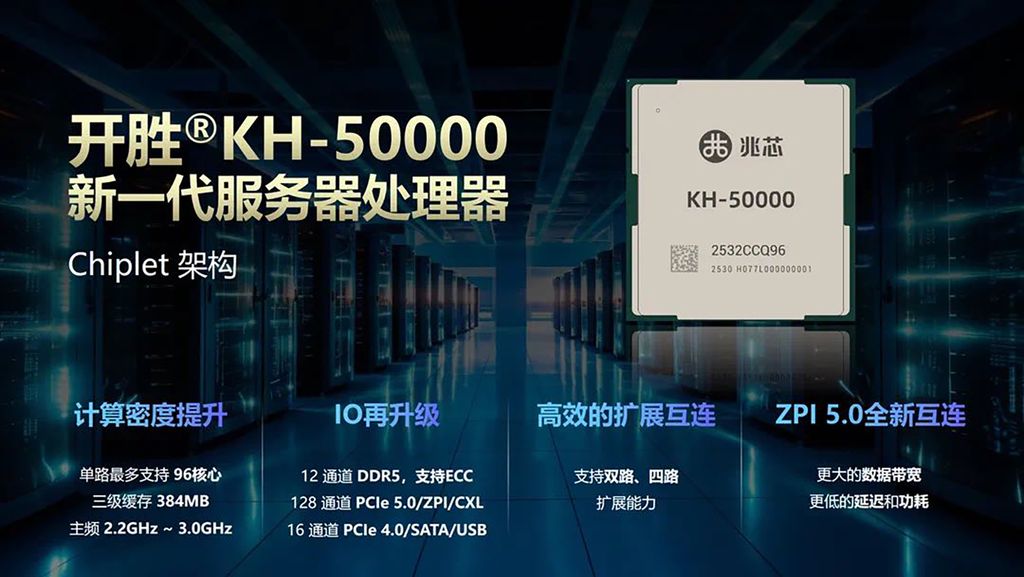
(Image credit: Zhaoxin)
Zhaoxin, one of China's top fabless semiconductor companies, has announced the company's next-generation KaiXian KX-7000N and Kaisheng KH-50000 processors at the World Artificial Intelligence Conference (WAIC) 2025. The former is a new consumer chip for AI PCs, while the latter is a server chip with specifications that rival AMD's EPYC portfolio.
The Kaisheng KH-50000, the successor to the Kaisheng KH-40000, will feature up to 96 cores, aligning with AMD's EPYC 9004 (codenamed Genoa) series. The forthcoming server processors provide three times the number of cores compared to Zhaoxin's current models. Nevertheless, the company has not disclosed whether the Kaisheng KH-50000 will incorporate simultaneous multithreading (SMT) or continue to operate without SMT, as is the case with the Kaisheng KH-40000.
While the Kaisheng KH-40000 employs Zhaoxin's Yongfeng architecture, the company has not disclosed which architecture is utilized for the Kaisheng KH-50000. However, considering the significant upgrades in specifications and features, it is reasonable to assume that the Kaisheng KH-50000 adopts a new architecture. Zhaoxin just didn't want to reveal which one yet.
Zhaoxin Kaisheng KH-50000 Processor Specifications
Processor | Architecture | Cores / Threads | Base Clock (GHz) | L3 Cache (MB) | PCIe Lanes | Memory Support | ZPI Support |
|---|---|---|---|---|---|---|---|
Kaisheng KH-50000 | ? | 96 / ? | 2.2 - 3.0 | 384 | 128 PCIe 5.0 | 12-channel DDR5 | ZPI 5.0 |
Kaisheng KH-40000 | Yongfeng | 32 / 32 | 2.5 | 64 | 128 PCIe 3.0 | 8-channel DDR4 | ZPI 3.0 |
In terms of clock speed, Zhaoxin may achieve a range between 2.2 GHz and 3.0 GHz for the Kaisheng KH-50000. This may be higher or lower than the Kaisheng KH-40000, which operates at 2.5 GHz. The increase in core count is also associated with an expansion of the L3 cache. Zhaoxin has officially confirmed that the Kaisheng KH-50000 is equipped with 384MB of L3 cache, a capacity that is six times greater than that of the Kaisheng KH-40000.
You may be aware that AMD's Genoa processors include 384MB of L3 cache. Indeed, the Kaisheng KH-50000 could potentially be an identical counterpart to Genoa. Similar to Genoa, the Kaisheng KH-50000 provides 128 PCIe 5.0 lanes and support for 12-channel DDR5 ECC memory, in addition to embracing the Compute Express Link (CXL) interconnect.
The Kaisheng KH-50000 supports ZPI (Zhaoxin Processor Interconnect) 5.0, allowing partners to install two or four chips on one motherboard. This enables systems with up to 384 cores.
KaiXian KX-7000N
Zhaoxin is riding the AI PC trend. The company revealed the upcoming KaiXian KX-7000N processor at WAIC. This chip is likely based on the KaiXian KX-7000 but features an added NPU for AI tasks, which is probably what the "N" signifies in its name.
The KaiXian KX-7000N marks a significant milestone for Zhaoxin, as it is the company's first chip to feature an NPU. Several AI PCs featuring the KaiXian KX-7000N were showcased at the WAIC 2025 event. However, Zhaoxin did not provide detailed specifications for the KX-7000N, only mentioning that it will have more cores and enhanced support for PCIe 5.0, unlike the current KaiXian KX-7000, which is limited to PCIe 4.0.
Companies such as Zhaoxin and Lisuan Technology are making significant advances in hardware. Although Chinese-made processors and graphics cards haven't yet challenged industry giants like Intel, AMD, or Nvidia, that remains a future objective. Currently, their focus is on creating reliable products that deliver a decent enough computing experience. Each progress, big or small, moves China closer to achieving technological independence from the West.
Follow Tom's Hardware on Google News to get our up-to-date news, analysis, and reviews in your feeds. Make sure to click the Follow button.

-
 C114 Communication Network
C114 Communication Network -
 Communication Home
Communication Home


